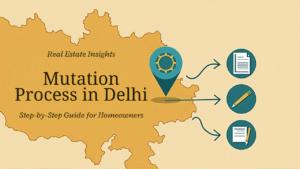As Indian cities grow denser, rooftops offer a green escape. These spaces don’t just boost beauty—they also help manage heat, energy use, water runoff, and biodiversity. In this guide, I’ll break down the top 5 green roof systems suitable for modern urban buildings in India. You’ll discover how they work, real examples, local service providers, and practical takeaways.
1. Extensive Green Roofs (Sedum & Wildflower Carpet)
What are they?
These are low-profile, lightweight systems with thin soil (5–8 cm) and hardy plants like sedums—ideal for retrofitting existing buildings.
Benefits
- Reduce rooftop temperature by up to 4.4 °C.
- Low maintenance and water needs.
- Light load (~4–8 kg/sq ft) and low cost.
Example
Many buildings in Pune and Mumbai have successfully added sedum green roofs to reflect heat and stay eco-friendly.
2. Intensive Green Roofs (Full Rooftop Gardens)
What are they?
These systems include lawns, flower beds, shrubs or even trees. Soil depth often exceeds 15 cm—this supports real garden use.
Benefits
- Act like aerial parks—great for relaxation or social spaces.
- Improve insulation and handle stormwater well.
Example
High-rise condominiums in Bangalore often feature rooftop parks with seating under lawns and trees—offering greenery at height.
3. Modular Green Roof Systems (Pre-Grown Trays)
What are they?
These are ready-made trays filled with soil and pre-grown plants, which sit over waterproofed roofs.
Benefits
- Fast installation—ideal for retrofits.
- Built-in irrigation reservoirs and integrated drainage.
- Easy to replace or rearrange modular units.
Example
ELT India’s modular trays are popular in urban retrofit projects—they include trays with 7 L soil/water reservoirs.
4. Flexi & Verdant Systems (Curved and Flexible Surfaces)
What are they?
Innovative systems like ELT’s Flexi and Verdant fit curved or pergola-style roofs, using foam or fabric panels with plants.
Benefits
- Adaptable to unusual roof shapes.
- Lightweight and visually dynamic.
- Great for pergolas or gazebos needing greenery.
Example
A café in Hyderabad used Flexi panels over shade structures, creating a living canopy that cools and beautifies the space.
5. Biodiverse Green Roofs (Wildlife-Friendly)
What are they?
These roofs use native plants meant to attract birds, bees, and butterflies—fostering a mini-ecosystem.
Benefits
- Boost urban biodiversity and habitat.
- Support conservation and sustainability goals.
- Often supported by green-building rating systems.
Example
Architects like RIS Architects in Pune design biodiverse roofs using local shrubs, wildflowers, and grasses to attract pollinators.
Why Green Roofs Make Sense in India
- Cooler interiors: These roofs lower indoor temps and reduce electricity use .
- Stormwater management: They retain up to 75% of rainwater, easing drainage systems.
- Longer roof life: Plants shield waterproofing membranes from sun damage.
- Improved air quality: Greenery filters dust and pollutants.
How Green Roofs Work: Rooftop Garden System Breakdown
- Waterproofing & root barrier – protect the building (e.g. bitumen, PVC sheet).
- Drainage layer – channels excess water and prevents waterlogging (e.g. Sika Aquadrain).
- Filter cloth – keeps soil from clogging the drain.
- Growing medium – lightweight soil mix needs to be suitable for local plants.
- Vegetation layer – choose sedums, grasses, shrubs or trees based on roof type.
Modular systems combine these layers neatly for fast build-out.
Cost & Maintenance Outlook
| System Type | Cost Approx. IN ₹ | Maintenance Level |
| Extensive | ₹200–400/sq ft | Low |
| Modular | ₹400–800/sq ft | Medium |
| Intensive | ₹800–1500/sq ft | High |
| Biodiverse | ₹500–1200/sq ft | Medium–High |
- Regular seasonal checks: irrigation, weeding, pruning.
- Professional inspection every 6–12 months.
How to Choose Your System
- Structural capacity: existing building may only hold light green roofs.
- Intended use: for leisure, go for intensive; for insulation, extensive works well.
- Aesthetics and ecology: choose biodiverse if you want wildlife; modular for ease.
- Budget and maintenance: lower upfront and upkeep with extensive types.
Local Vendors & Service Providers
- Vertvista (Mumbai) – Offers extensive and intensive solutions, including engineering support.
- ELT India (Pan-India) – Known for modular, flexi, and verdant systems for various building types.
- IGBC/GRIHA – Certification bodies that recommend green roofs in sustainable rating systems.
- Local landscape architects – Firms like RIS Architects (Pune), Studio Lotus (Delhi) offer biodiverse rooftop designs .
Final Takeaways
Green roofs are smart investments—not just green décor. From energy savings and stormwater retention to boosting biodiversity and extending roof lifespan—these systems pay multiple dividends. Choose the right type for your building’s structure, climate, and your purpose. Whether it’s an extensive roof, an intensive terrace garden, a fast modular system, a flexible verdant panel, or a wildlife-friendly biodiverse roof, your rooftop can become a thriving eco-oasis right in the sky.
Start small or go big—either way, your green roof will refresh your world—and help cities become cooler, greener, and more sustainable.
Source : fulinspace.com

